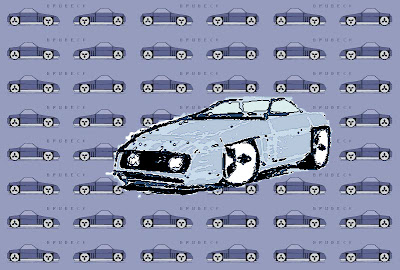Flat-Panel Design
_____
There have been quite a few vehicles, over the decades, with very straight lines and panels that were nearly flat. One in particular comes to mind (this is the later, smoothed-down version):
1989 Aston Martin Lagonda
The house of Bertone did a lot of wedgy things in the Seventies and into the Eighties, as did former Bertone employee Giorgio Guigaro (original Golf/Rabbit, Scirocco etc), but these designs are by William Towns.
Behind the Microdot is the Hustler, the only vehicle I know of with purely rectangular wheel openings, and one I wasn't aware of, years ago, when I was messing around in MS Paint and accidentally came up with something that would forever change my design ethos...



The three-diamond wheels you see above? At the time I was hoping to come up with a presentation for a Mitsubishi design contest, so I incorporated their logo. After the deadline whooshed by, I continued to develop the Brubeck...



...and eventually came up with the "Tenfold" wheels shown here, in this crude representation. Each spoke and slot occupies the exact same amount of space. It's a simple yet carefully considered wheel design, entirely appropriate for mounting on a simple yet carefully considered flat-panel vehicle.
WHY FLAT PANELS?
The straight lines on the first Brubeck MS Paint sketch weren't meant to last. I was merely trying to overcome the blank page syndrome (akin to writer's block) by creating a simple image. It was to be something to work from -- or perhaps it was merely an exercise. That contest was over five years ago, so I can't quite recall... Anyway, I was so quickly overcome by the potential of the design that it immediately became my main focus. I was listening to some vintage Dave Brubeck vinyl at the time...
Before long I realized that, beyond being different, flat-panel bodies would be very easy to construct in comparison with what we're used to seeing. Back in the day, curved metal panels were pounded out over a wooden buck. Mass production brought enormous dies that stamp sheets of metal into shape. Fiberglass, carbon fiber, and other composite body panels require a mold. However for flat panels all you need is a pressbrake -- and a welder, if you have more complex shapes such as the Brubeck's endcaps (bumpers).
Then for the windows, readily-available flat glass can be cut to shape -- no need to find existing windshields and backlights to modify, or to have custom pieces made.
There you have it. To build flat-panel bodies, you need fewer tools and no tooling. Add a welded square-tube steel spaceframe for a chassis, and the biggest piece of model-specific equipment you'll have lying around will be your frame jig.
Suddenly, the dream of building a car of my own design was in exponentially closer reach. Still very much a dream, mind you, but one much easier to attain.

Here is an early version of BRUTRUCK, a concept I've recently revisited and refined. The new version, which is based on the EXOVAN platform, might be called BRUTRUCK Model G... Not ready to show sketches yet.
The Brubeck sports car is conceived as a farewell to internal combustion, with its pair of propane-burning Kawasaki Ninja ZX14 engines and rear-wheel-drive -- however an electric version is inevitable. An electric Brubeck will obviously lack one significant feature -- the in-your-face quad exhaust, to be replaced with round taillights -- but there is no reason for body modifications, other than a slight adjustment to the rear cap, closing the vertical gap (instead of a wrapover rear light cluster, there will be a simple horizontal bar for the third brake light).
There is another flat-panel concept I've been toying with over the past few years, that only recently has begun to look right in my mind's eye. Sure to be compared to the Aston Martin Lagonda, the Time Further Out -- yes, named after a Dave Brubeck album -- is an electric luxury touring sedan suitable for chauffeured red-carpet arrivals, something that valets will choose to park out front...
A very recent addition to the conceptual Tellurian Motors stable is the Salt Flats Runabout, which happens to be very similar to William Towns' Microdot, shown at the top of this page -- but then again, it is very different. For one, of course it will use no molded panels. Two, it will not have anything people would normally call a 'body'. Suspended within an exposed metal frame will be sheets of mirrored glass, and battery boxes will hang below the beltlines on the sides. The glass doors, very much like those on the Microdot, will swing up gullwing-style but will have a full trapezoidal profile and small round access ports.
These ports will be very useful. The benefits of the powerful air conditioning unit (running off its own motor) would quickly go to waste each time one of those doors is opened. If you want to talk to someone, or hand off or receive a small item, open a port. A removable, flip-up panel -- call it a moonroof if you like -- in combination with these ports will provide some ventilation at lower temperatures...
--o-o
The one-off Salt Flats Runabout is intended purely for one location, the Bonneville Salt Flats, and various events held there every year. While it has dimensions similar to those of the Microdot, its roof will be a few inches lower, and its sloping sides will allow for only 2 occupants, not 3. Those 2 occupants will be able to navigate around pit areas in cool comfort, shielded from the sun (and prying eyes) while still being able to enjoy the surrounding vista. Battery life will be measured in hours, not miles...
Yes, it could be made available for futuristic music videos and movies, should such a demand arise...
Any questions?
Phil Smith
July 31, 2007
_____



